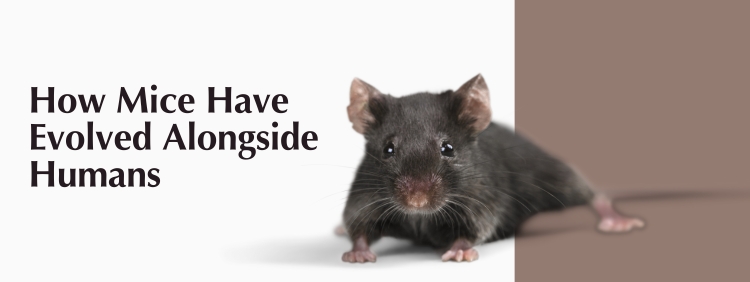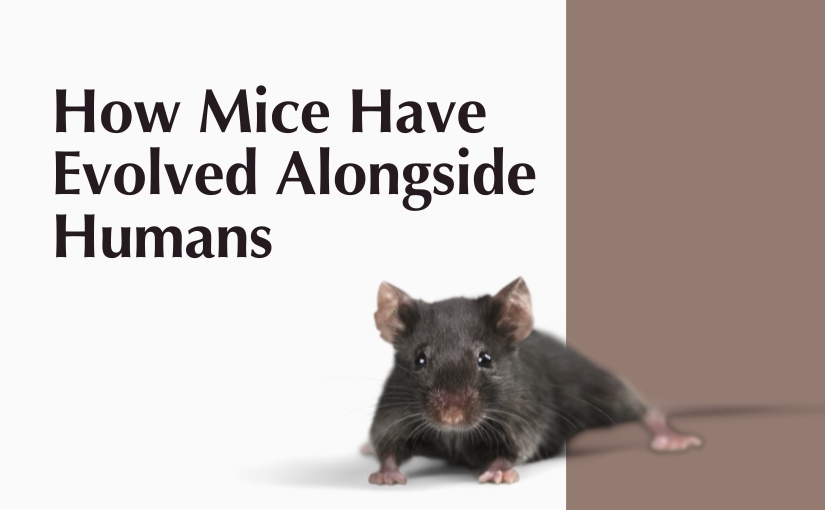
Mice are more than just a nuisance plaguing our homes and businesses. These tiny rodents have a long and fascinating history, dating back millions of years. But it wasn’t until humans appeared on the scene that mice truly began to evolve. Over time, they have adapted to live alongside us, taking advantage of our structures and food supplies. In fact, today’s common house mouse is a far cry from its wild ancestors, having developed unique behaviours and features that make it ideally suited to urban and suburban life. Humans have long struggled with mice control, to no avail.
In this article, we’ll explore the evolution of mice alongside humans and look at attempts to keep these pesky pests at bay.
The Origins Of Mice: An Ancient Connection To Humans
Unbeknownst to many, the relationship between humans and mice started evolving together more than ten thousand years ago. When our ancestors made the monumental shift from nomadic hunter-gatherer lifestyles to settled farming communities – an era known as the Neolithic revolution – the grain stores attracted and served mice as a new, abundant food source. This period marked the beginning of the commensal relationship, where they began living in close proximity to humans, a phenomenon that significantly impacted their evolutionary course.
Scholars believe that the first signs of this relationship appeared in the ancient Egyptian civilization. Archaeological evidence suggests that these societies were familiar with the concept of rodent infestations.
The Evolution of House Mice
Today’s house mouse, scientifically known as Mus musculus, evolved with many traits that made it particularly well-suited to living alongside humans. Unlike their shy and woodland-inhabiting ancestors, they display little fear of humans. They have adapted to gnaw through hard substances, such as plastic and thin metal, to reach stored food. Furthermore, house mice have developed a keen ability to reproduce rapidly, granting them a significant advantage in the perennially competitive game of survival.
The Spread of Mice: Following Human Migration
Mice species also used human migration to their benefit. As humans explored and colonized new territories across the world, these rodents hitched a ride on boats and wagons. From Africa to Asia, Europe to the Americas, the distribution of mice is a mirror image of historical human migration.
Interestingly, by studying the genetics of present-day mice, scientists can even trace the routes followed by ancient human explorers and settlers. It is a fascinating example of how we can uncover history not just from human artifacts but from the digital routes found within the genomes of the humble house mouse.
The Human Impact on Mouse Evolution
One of the most striking examples of human-initiated mouse evolution is the development of distinct urban and rural populations. In cities, where resources like food and shelter are plentiful but competition is fierce, mice have evolved to become more tenacious than their rural counterparts. Alternatively, mice in rural areas, dealing with scarce resources and predators, have developed a more alert and cautious response.
In the grand scheme of evolution, human beings have played a significant role in directing the course of the house mouse’s development. From its early origins to its present-day diversity, the story of the mouse is indeed a fascinating tale of co-evolution with mankind.
Rodent-Proofing: How Humans Have Attempted To Keep Rodents Away
If you’ve ever spent a cold winter night with a mouse scrambling in the attic, you know how challenging it can be to keep mice out. Over the years, humans have devised numerous methods to protect their homes and food stores. This has been no mean feat, as these agile, adaptable creatures have managed to find their way around most obstacles.
The Ancient Art of Rodent-Proofing
In ancient times, our ancestors devised simple yet effective strategies for curbing the mouse menace. They stored grains and food supplies in rodent-proof containers and built houses with high foundations and tightly fitting doors. Ancient Egyptians even worshipped a mouse-fearing goddess to keep these critters at bay.
The Middle Ages and Beyond: Invention of Traps
History books are filled with evidence of mankind’s efforts to deter mice invasion. The Middle Ages brought the invention of mouse traps, the effective device that is still in use today. Back then, traps were often homemade, composed of wood and metal, and baited with food.
Does Modern Technology Have the Answer?
Jump to the present day, and we’re still perfecting our anti-rodent strategies. Advances in technology have given rise to electronic rodent repellents that emit high-frequency noises, supposedly repelling mice. Additionally, pest control professionals now utilize methods such as ultrasonic devices, chemical baits, and traps with integrated technologies.
Despite our centuries-long battle against these nimble rodents, it seems we haven’t quite won the war. Mice are still common household pests today. But why?
The answer lies, once again, in evolution. As we have developed and refined our strategies to keep pests at bay, they have simultaneously adapted their behaviour and biology to best our defences. This persistent pattern makes one thing clear – the battle with mice is indeed an evolutionary arms race.
A Mouse Response To Human Mice Control
In this centuries-long match between humans and mice, one might wonder how these resilient rodents have responded to the various obstacles we’ve implemented. As time progressed, they have exhibited a remarkable ability to circumvent the best strategies of our mice control services. Let’s explore the fascinating ways in which mice have responded and evolved in this ever-escalating evolutionary arms race.
Constant Battle of Adaptation
Mice are known for their adaptability. As humans developed and deployed new strategies to fend off these pests, mice evolved accordingly. An intriguing example of this is seen in their resistance to poison. Initially, rodent poisons were almost universally effective; but over time, the process of natural selection favoured mice that could withstand these toxic substances. Populations gradually developed resistance to common rodenticides, stimulating the continual development of new, stronger poisons.
Behavioural Changes in Response to Traps
Apart from the physiological evolution, mice have also shown signs of adapting behaviourally to removal countermeasures. They have learned to recognize and avoid threats. Despite the evolution of mouse traps from rudimentary devices to complex contraptions, mice have become notably adept at evading them. This is likely driven by a learning process, where they observe and learn from the experiences of their fellow rodents, leading to the survival of the ‘wisest’.
The dynamic nature of this evolutionary ‘arms race’ has fascinating implications for both human and mouse populations. As we seek better ways to manage rodents, they continue to outwit, evolve, and survive. This persistence in adaptation demonstrates the continuous ebb and flow of natural development.
Predicting The Continued Evolution Of Mice Alongside Humans
As we look to the future, it’s almost a certainty that mice will continue to evolve alongside us. The co-evolution of these two species is an ongoing tale as old as civilization itself. Just as we adapt and innovate, mice too, demonstrate an astonishing ability to adjust and respond based on the pressures we impose on them and the environment.
In this unfaltering evolutionary arms race, one can’t help but admire the resilience, adaptability, and vitality of these small creatures. As the story continues to unfold, it serves as a testament to the power of evolution and the intricacies of our interconnected walk through time.
Professional Pest Control Services
Armed with this vital information about the survival of mice and their interactions with humans, you can see why it is vital to call a professional service if you suspect your home is suffering with an infestation.
Not only can mice cause serious damage to your property, but they can also pose health risks to your family. Rodents are notorious for gnawing on electrical wires and creating structural damage by chewing through wood and drywall. In addition, they are known carriers of diseases, which can spread to humans through their urine and droppings.
Whether you notice chew marks on your walls or hear scratching in your attic, it’s important to address the problem as soon as possible. Professional pest control services from Truly Nolen Canada can help you eliminate the infestation and prevent further issues down the line.
Truly Nolen has developed a unique program to help homeowners keep their properties pest-free all year round. Known as the Four Seasons program, it is designed with a deep understanding of pest behaviour changes throughout the year.
At the core of this program is a thorough inspection by our Truly-Trained technicians to identify all potential entry points and nesting spots. Based on the findings, a customized pest control plan is created that takes into account the specific needs of your home, including the life cycles of the pests in question. With our Four Seasons program, homeowners can enjoy peace of mind, knowing their homes are protected from pests, no matter the season.
Contact us today to learn more about our Four Seasons program and how we can keep your home free of rodents.
